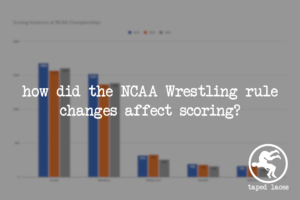Buried deep within the United World Wrestling website, there is a calculation they use to determine the “Most Successful Wrestler” for a given event. They don’t really use it for anything; it’s just an interesting way of quantifying performance. The calculation is as follows:
MSW = (WQ / minW – WQ / minL) + (CPW / NM – CPL / NM)
MSW: Most Successful Wrestler (Index)
WQ / minW: Points Won per Minute
WQ / minL: Points Lost per Minute
CPW: Classification Points Won
CPL: Classification Points Lost
NM: Number of Matches
Now this is somewhat reductive in a qualitative sense, and misses some of the nuances of evaluating performance, namely strength of competition. But it is an interesting metric, and the emphasis on points scored and points lost is a great way of rewarding those wrestlers that create more action. Looking at the calculation from last year’s world championships, the results pretty much align with public perception. The top three Most Successful Wrestlers for men’s freestyle were Tazhudinov (7.95), David Taylor (6.66) and Vito Arujau (5.04). The top three Most Successful Wrestlers for Women’s freestyle were Ozaki (8.04) Fujinami (7.94) and Susaki (6.66).
The calculation is pretty all-encompassing quantitatively. Points-per-minute rewards wrestlers for quick terminations via technical superiority or a fall, and the inclusion of classification points rewards wrestlers for dominant wins. If you aren’t aware, in freestyle and Greco-Roman wrestling you can earn a classification point even in defeat if you score a technical point during the match. Trying to apply this folkstyle, it doesn’t cross over perfectly for the reason just mentioned, but the basic premise still works. I analyzed the 10 champions at the 2024 NCAA championships using a very slightly modified version: MSW = (WQ / minW – WQ / minL) + TP / NM, where TP represents the number of team points earned. The results are as follows:
| Rank | Wrestler | Weight | MSW |
| 1 | Brooks | 197 | 7.33 |
| 2 | Keckeisen | 184 | 6.89 |
| 3 | Haines | 157 | 6.53 |
| 4 | Arujau | 133 | 6.09 |
| 5 | Kerkvliet | 285 | 5.93 |
| 6 | Mendez | 141 | 5.76 |
| 7 | Henson | 149 | 5.57 |
| 8 | Carr | 165 | 5.50 |
| 9 | Figueroa | 125 | 5.23 |
| 10 | Starocci | 174 | 4.46 |
Again, I would say this roughly aligns with general perception of the event. Fan voting results for the Hodge Trophy, which only included undefeated wrestlers, went 1. Brooks, 2. Keckeisen, 3. Starocci, 4. Haines, 5 Kerkvliet. Starocci is the outlier here as his injury severely limited his point scoring capabilities at this tournament, but otherwise the fan vote follows this MSW index pretty closely.
So is there a practical implication of this? Probably not. I don’t really see a Moneyball scenario where coaches are suddenly recruiting based on MSW index scores. But for discourse the main metrics we tend to use are bonus rate, pins, and, to a lesser extent, dominance score, and I’ve always felt these didn’t quite paint a full picture. Rewarding early termination and accounting for every point won and lost rather than looking at discrete metrics of decision, major, tech fall, and fall gives a more fleshed-out metric for comparing the performance of wrestlers. For what it’s worth, the 2021 Hodge Trophy was presented to both Spencer Lee and Gable Steveson due to a “virtual tie” between the two in voting. Analyzing both wrestlers’ entire seasons using MSW, Spencer Lee had an MSW index of 8.50, while Gable Steveson had an MSW index of 7.91.




